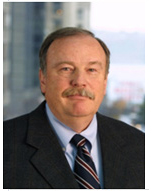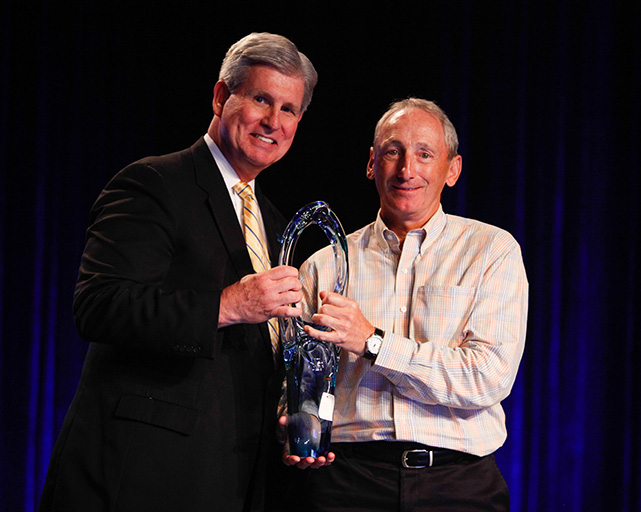IAVM Member Named CIC Hall of Leaders Inductee
 Congratulations to IAVM member John Christison, principal and managing member at BCI+Network, on being named a 2014 inductee into the Convention Industry Council (CIC) Hall of Leaders!
Congratulations to IAVM member John Christison, principal and managing member at BCI+Network, on being named a 2014 inductee into the Convention Industry Council (CIC) Hall of Leaders!
“The CIC Hall of Leaders is the highest honor to be bestowed in our industry. This year’s class truly embodies the qualities that are the hallmark of this award. They are the influencers and forward-thinkers who have shaped this industry and inspired many of us to be better leaders,” said IAVM member Karen Kotowski, CAE, CMP, CEO of the Convention Industry Council. “We are pleased to be back in Las Vegas for IMEX America week where the industry’s best and brightest will meet face to face.”
The awardees will be formally recognized at the Hall of Leaders Gala on Sunday, October 12, 2014, at the MGM Grand Resort & Casino in Las Vegas, kicking off IMEX America week.
The Hall of Leaders recognition program draws attention to the contributions that the meetings industry has made to the larger society as a whole by highlighting the specific achievements of industry pioneers and emerging leaders who not only changed the landscape of the profession, but changed the culture of business as well. Nominations are submitted either by CIC member organizations or the general industry community and honorees are recognized during the culminating awards ceremony and their stories housed virtually at www.conventionindustry.org/vhol.
Hotel Scam Alert!
 If you or your staff are directly contacted by anyone claiming to represent IAVM that asks you to alter your hotel reservations or tells you that our Portland conference block at VenueConnect 2014 is full, please know that this is a scam that we are actively monitoring and responding to. You can always reach (the actual!) IAVM staff by calling 1-972-906-7441 or through email meetings@iavm.org.
If you or your staff are directly contacted by anyone claiming to represent IAVM that asks you to alter your hotel reservations or tells you that our Portland conference block at VenueConnect 2014 is full, please know that this is a scam that we are actively monitoring and responding to. You can always reach (the actual!) IAVM staff by calling 1-972-906-7441 or through email meetings@iavm.org.
Seat Raising in the Swiss Tech Convention Center
Here’s one way to impress meeting planners: convertible seating.
Consider, for example, the new Swiss Tech Convention Center in Lausanne, Switzerland, which features a 3,000-seat amphitheater that is fully modular. It houses a system of motorized swivel pins attached to each row of seats and concealed under the platform structure. The seats are raised or lowered, depending on what is needed for the meeting or event. The transformation takes approximately 15 minutes.
The convention center also features dye-sensitized solar cells, called Grätzel cells, that convert electricity similar to photosynthesis in plants.
“What we are doing with this convention center is a display of technology, a platform intended to draw attention to a remarkable device invented at our labs, to full-scale test this technology and to demonstrate its significant architectural potential,” Francis-Luc Perret, vice president for planning and logistics at Ecole Polytechnique Fédérale de Lausanne, told Phys.org.
Really, though, you should watch the video below. Now only will you learn more about the convention center’s convertible seating capabilities (around the two-minute mark), you’ll also be treated to the most serious sounding music I’ve ever heard accompany a venue marketing effort.
Gaylord Family – Oklahoma Memorial Stadium Set to Expand
KWTV is reporting that Oklahoma University will expand its stadium.
“The project would commence following the final home game of the 2014 season against Oklahoma State on Dec. 6, with work being basically done around the clock,” Dean Blevins reported for KWTV.
The Gaylord Family – Oklahoma Memorial Stadium expansion will cost an estimated $350-400 million dollars, and seating will increase from 82,112 to 88,000. Suites will be upgraded, new suites will be installed in the south end zone, and training and dressing facilities will be upgraded.
Check out the KWTV website for more information about the expansion and upgrades.
(photo credit: Curtis Simmons via photopin cc)
Apply Today for the 2014 Venue Education Award
We’re accepting Venue Education Award nominations through Friday, May 30. The award acknowledges allied organizations, venues, and academic institutions that demonstrate active student involvement, excel in available educational opportunities as well as demonstrate leadership in education. The award also honors individuals who are actively involved in the education and continuous development of the venue management industry. Self-nominations will be accepted.
Last year’s recipient was Maple Leaf Sports & Entertainment Ltd. (MLSE), and the award was accepted by Bob Hunter, CFE (pictured above, right, with Dr. Tim Nash from Northwood University). What made the organization stand out was that it worked with area colleges and universities to develop and execute on formal and rewarding internship programs to the benefit of the venue and educational community and to the students. MLSE also worked with the community in inviting area educational institutions K-12 and beyond to bring student groups through the venue to promote the business, teams, concerts, and events while simultaneously promoting job opportunities and careers.
“This allows students to familiarize themselves with other areas within venue management and network with other employees while contributing to charitable initiatives within the community,” MLSE wrote in its application. “It also gives them an opportunity to gain exposure to some unique events such as rink/court/pitch refurbishments, fundraising dinners/galas, and other exciting opportunities for learning, growth and development.”
If you’re actively encouraging and facilitating educational opportunities for members and future leaders of the venue management industry, then please apply for the Venue Education Award by Friday, May 30.
Do you want to receive a Front Row News weekly digest?
Categories
- Allied (861)
- Architecture (147)
- Arenas (747)
- Career (897)
- Convention Centers (895)
- Education (623)
- Events (1,544)
- Food & Beverage (193)
- Foundation (113)
- Guest Experience (1,496)
- Industry News (2,270)
- Leadership (1,888)
- Marketing (150)
- Membership (2,000)
- Music (213)
- Performing Arts Centers (454)
- Professional Development (409)
- Research (127)
- Safety & Security (442)
- Sports (763)
- Stadiums (608)
- Student (159)
- Technology (516)
- Ticketing (92)
- Touring (82)
- Trends (364)
- Uncategorized (743)
- Universities (218)
- Video (25)
- Young Professional (198)
Twitter Feed
- Twitter feed loading
Recent Posts
- Venuworks and ATG Entertainment Selected to Manage Fresno Convention and Entertainment Center
- Seattle Convention Center Announces Strategic Leadership Appointment and Growth Initiatives for 2026
- Peggy Daidakis Humbly Made Convention Center History
- Welcome to Our Newest Members
- New Member Benefit! IAVM Partners with Advantage Training to Elevate Staff Readiness and Guest Experience
Categories
- Allied
- Architecture
- Arenas
- Career
- Convention Centers
- Education
- Events
- Food & Beverage
- Foundation
- Guest Experience
- Industry News
- Leadership
- Marketing
- Membership
- Music
- Performing Arts Centers
- Professional Development
- Research
- Safety & Security
- Sports
- Stadiums
- Student
- Technology
- Ticketing
- Touring
- Trends
- Uncategorized
- Universities
- Video
- Young Professional
Archives
- December 2025
- November 2025
- October 2025
- September 2025
- August 2025
- July 2025
- June 2025
- May 2025
- April 2025
- March 2025
- February 2025
- January 2025
- December 2024
- November 2024
- October 2024
- September 2024
- August 2024
- July 2024
- June 2024
- May 2024
- April 2024
- March 2024
- February 2024
- January 2024
- December 2023
- November 2023
- October 2023
- September 2023
- August 2023
- July 2023
- June 2023
- May 2023
- April 2023
- March 2023
- February 2023
- January 2023
- December 2022
- November 2022
- October 2022
- September 2022
- August 2022
- July 2022
- June 2022
- May 2022
- April 2022
- March 2022
- February 2022
- January 2022
- December 2021
- November 2021
- October 2021
- September 2021
- August 2021
- July 2021
- June 2021
- May 2021
- April 2021
- March 2021
- February 2021
- January 2021
- December 2020
- November 2020
- October 2020
- September 2020
- August 2020
- July 2020
- June 2020
- May 2020
- April 2020
- March 2020
- February 2020
- January 2020
- December 2019
- November 2019
- October 2019
- September 2019
- August 2019
- July 2019
- June 2019
- May 2019
- April 2019
- March 2019
- February 2019
- January 2019
- December 2018
- November 2018
- October 2018
- September 2018
- August 2018
- July 2018
- June 2018
- May 2018
- April 2018
- March 2018
- February 2018
- January 2018
- December 2017
- November 2017
- October 2017
- September 2017
- August 2017
- July 2017
- June 2017
- May 2017
- April 2017
- March 2017
- February 2017
- January 2017
- December 2016
- November 2016
- October 2016
- September 2016
- August 2016
- July 2016
- June 2016
- May 2016
- April 2016
- March 2016
- February 2016
- January 2016
- December 2015
- November 2015
- October 2015
- September 2015
- August 2015
- July 2015
- June 2015
- May 2015
- April 2015
- March 2015
- February 2015
- January 2015
- December 2014
- November 2014
- October 2014
- September 2014
- August 2014
- July 2014
- June 2014
- May 2014
- April 2014
- March 2014
- February 2014
- January 2014
- December 2013
- November 2013
- October 2013
- September 2013
- August 2013
- July 2013
- June 2013
- May 2013
- April 2013
- March 2013
- February 2013
- January 2013
- May 2012
- March 2012
- December 2011
- November 2011
- October 2011
Recent Comments
- Frank Bradshaw, Ph.D., CVE on John Meyer, CVE, a Tireless Advocate of Certification for Venue Professionals, Has Died
- Neil Sulkes on Hilary Hartung, Friend to Many in Venue Marketing, Has Left Us
- Jason Parker, CVE on The Devastation of Hurricane Helene and How We Can Support One Another
- Larry Perkins on Touhey Testifies Against Speculative Ticketing Before Congressional Subcommittee
- Peter Secord on Major Players for Planned Elkhart Amphitheater Were in the Mix at VenueConnect



